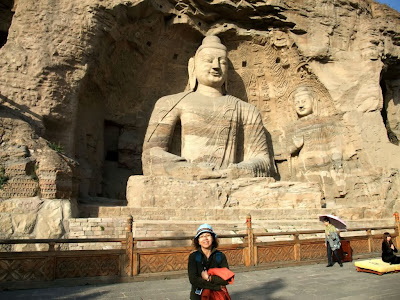
The project of Yungang Grotto (云冈石窟) began in 5th century during Northern Wei Dynasty (386-534). When northern region of China was under the control of Tuoba Clan after decline of Jin Dynasty. Northern Wei made Pingcheng (Datong)as its capital and with Chinese influences, imperial policy of assimilation was set and established. Buddhism was adopted as its state religion and commencing from year 460, Emperor began to erect and carve huge Buddha statue near the capital city declaring the Emperors as the representatives of Buddha and legitimate rulers of China.



Cave No.5 and 6 were excavated under the supervision and support of imperial court in the reign of Emperor Xiaowen-Di between years 465-494 before the capital was moved to Luoyang. Cave 5 was divided into two parts. Image of The seated Buddha Sakyamuni sculpted from the back wall measured as high as 17 meters. The whole grotto was full of niches enshrined with Buddhist images.



As per experts, the external part of Buddha's great statue had been restored with clay in Tang Dynasty (618-907).




The two Buddha seated inside a niche at west corner of Cave 5, was derived from Dharma Flower Sutra where the past Buddha Duobao-fo (多宝佛)came to listen to the Sutra and shared the seat with Buddha Sakyamuni, who at that time was giving summons of the Dharma Flower Sutra to all Bodhisattva and his disciples.


The amazing colored sand stone carving sculptures that remain intact and vivid for more than 1500 years in history..




Buddhist images carved at the surrounding walls of Cave 5.















The 4-storey high wooden Building extant in front of Caves 5 and 6 were built in year 1651 during early Qing dynasty to protect the sand stone of the grotto being weathering.


Top of the columns in the wooden building was to protect the caves from too exposed to the heavy weathering.


Cave 6 appeared almost square in shape with a height of 20 meters, was the largest grotto at site. Connecting to the ceiling top was a two storey 15 meter high square pagoda, with four Buddha Images carved at 4-sides of the pillars and a mini sized 9-tiers pagoda on the back of elephant were carved at 4 corners of the Pagoda Top.


The 4 walls of Grotto were covered up with Buddhist images and the ceiling was decorated with beautifully carved Heavenly Deva and their rides from the 33 realms. Legends of Buddha Sakyamuni from birth to enlightenment was depicted on the 33 embossed panels around the Pagoda columns and at the center part of its three walls.



The scheme of Cave No. 6 is rather huge and magnificent with abundant remarkable Buddhism relics. It is a representative symbol of a great piece of sculptural arts from 5-6th century. Unfortunately, the cave was under repaired and we did not have the chance to admire full pictures of this incredible Buddhist relic.


Block of grotto appear like abandon castles with opening windows.


Buddhist images at the wall of Cave No 3.



It was said that the 25 meter high Cave No.3 was also the original Tanyao Sutra Translated House (昙曜译经楼) named after the monk Rev. Tanyao who was in charge of the Yungang Project during Northern Wei Period. The main sculpture at the central square grotto at the front part is a Standing Image of Buddha Maitreya.



The Image of Future Buddha Maitreya at Cave No. 3






The back room of Cave 3 was caved with images of a Buddha Image with two Boddhisattva. The Seated Buddha with a round fatten face was 10 meter in height while the two standing Bodhisattva is 6.2 meter high. The carving style and skill according to experts, were closer to the art products of early Tang Dynasty. Cave No. 16 was carved with a good looking standing image of Buddha Sakyamuni with height of 13.5 meter.




Cave No. 16 to 20 named as Tanyoa Five Grotto (昙曜五窟) were the first patch of cave excavated under the in-charge of Rev. Tanyao. The five sculptures were carved with 5 Emperors (Daowu 道武帝, Mingyuan 明元帝, Daiwu 太武帝, jingmu 景穆帝 and Wencheng 文成帝) as model base, into the past, the present and the future Buddha Images, similar in style but not identical. With thousand of Buddhist images caved on the external walls, all the imposing 5 grotto were huge in scheme and forceful in appearance. The 16.8 meter high seated Buddha Image at Cave No. 19 looks elegant and handsome.



A vigorous look seated image of future Buddha Maitreya, with height of 15.6 meter was enshrined in a comparatively compact Cave No. 17. And the standing Buddha Statue with robe embossed with thousand Buddha Images at Cave 18, appeared dignified and lively (Surprisingly neck-tie had been part of the attire for ancient Chinese for more 1500 years ago).



Cave No. 20 holds a huge seated Buddha image at open air measured nearly 14 meter in height. It is the symbolic statue of Yungang Grotto site. The image looks martial and stately with broad shoulders, round face, big ears, thin lips, deep eyes with high nose fully depicting the ethnic culture at that time.



The huge sculpture of Buddha Image was originally built inside a grotto in Cave 20, but the front wall and grotto top collapsed making the entire image exposed outside.


Peace in mind when standing in front of the huge seated Buddha Image under evening sun shine.





Side view of The seated Buddha Image at Cave No. 20.




We have visited three out the four great grotto in China and Yungang is the most amazing. It is indeed a wonder in the world of sculpture arts that graphically tells us the story of the past glory.



The exist way.



The demonstration of ancient way of preparing the maltose.



No comments:
Post a Comment